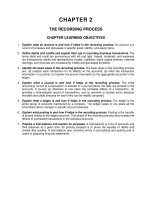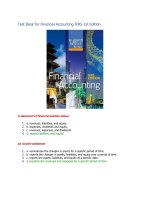Financial accounting IFRS 4 kieoso ch09 PPT
Bạn đang xem bản rút gọn của tài liệu. Xem và tải ngay bản đầy đủ của tài liệu tại đây (530.06 KB, 98 trang )
Financial Accounting
IFRS 4th Edition
Weygandt ● Kimmel ● Kieso
Chapter 9
Plant Assets, Natural Resources, and Intangible Assets
Chapter Outline
Learning Objectives
LO 1
Explain the accounting for plant asset expenditures.
LO 2
Apply depreciation methods to plant assets.
LO 3
Explain how to account for the disposal of plant assets.
LO 4 Describe how to account for natural resources and
intangible assets.
LO 5 Discuss how plant assets, natural resources, and intangible assets are reported and analyzed.
Copyright ©2019 John Wiley & Sons, Inc.
2
Learning Objective 1
Explain the Accounting for Plant Asset Expenditures
Copyright ©2019 John Wiley & Sons, Inc.
3
Plant Asset Expenditures (1 of 2)
Plant assets are resources that have
•
physical substance (a definite size and shape),
•
are used in the operations of a business,
•
are not intended for sale to customers,
•
are expected to provide service to the company for a number of years, except for land.
Referred to as property, plant, and equipment; plant and equipment; and fixed assets.
Copyright ©2019 John Wiley & Sons, Inc.
4
Plant Asset Expenditures (2 of 2)
Plant assets play a key role in ongoing operations.
Copyright ©2019 John Wiley & Sons, Inc.
5
The Cost of Plant Assets (1 of 10)
Historical Cost Principle
•
Requires that companies record plant assets at cost
•
Cost consists of all expenditures necessary to acquire an asset and make it ready for its
intended use
Copyright ©2019 John Wiley & Sons, Inc.
6
The Cost of Plant Assets (2 of 10)
Land
All necessary costs incurred in making land ready for its intended use increase (debit) the Land
account.
Costs typically include:
1.
cash purchase price
2.
closing costs such as title and attorney’s fees
3.
real estate brokers’ commissions
4.
accrued property taxes and other liens on land assumed by purchaser
Copyright ©2019 John Wiley & Sons, Inc.
7
The Cost of Plant Assets (3 of 10)
Illustration: Lew Ltd. acquires real estate at a cash cost of HK$2,000,000. The property contains an old
warehouse that is razed at a net cost of HK$60,000 (HK$75,000 in costs less HK$15,000 proceeds from
salvaged materials). Additional expenditures are the attorney’s fee, HK$10,000, and the real estate broker’s
commission, HK$80,000. Determine the amount to be reported as the cost of the land.
Copyright ©2019 John Wiley & Sons, Inc.
8
The Cost of Plant Assets (4 of 10)
Required: Determine amount to be reported as the cost of the land.
Land
Cash price of property (HK$2,000,000)
HK$2,000,000
Net removal cost of warehouse (HK$60,000)
60,000
Attorney's fees (HK$10,000)
10,000
Real estate broker’s commission (HK$80,000)
80,000
Cost of Land
HK$2,150,000
Lew makes the following entry:
Land
2,150,000
Cash
2,150,000
Copyright ©2019 John Wiley & Sons, Inc.
9
The Cost of Plant Assets (5 of 10)
Land Improvements
Structural additions with limited lives that are made to land. Cost includes all expenditures
necessary to make the improvements ready for their intended use.
•
Examples: driveways, parking lots, fences, landscaping, and underground sprinklers
•
Limited useful lives
•
Expense (depreciate) cost of land improvements over their useful lives
Copyright ©2019 John Wiley & Sons, Inc.
10
The Cost of Plant Assets (6 of 10)
Buildings
Includes all costs related directly to purchase or construction.
Purchase costs:
•
Purchase price, closing costs (attorney’s fees, title insurance, etc.) and real estate broker’s
commission
•
Remodeling and replacing or repairing the roof, floors, electrical wiring, and plumbing
Copyright ©2019 John Wiley & Sons, Inc.
11
The Cost of Plant Assets (7 of 10)
Buildings
Includes all costs related directly to purchase or construction.
Construction costs:
•
Contract price
•
Payments for architects’ fees
ã
Building permits
ã
Excavation costs
Copyright â2019 John Wiley & Sons, Inc.
12
The Cost of Plant Assets (8 of 10)
Equipment
Include all costs incurred in acquiring the equipment and preparing it for use.
Costs typically include:
•
Cash purchase price
•
Sales taxes
•
Freight charges
•
Insurance during transit paid by purchaser
ã
Assembling, installing, and testing
Copyright â2019 John Wiley & Sons, Inc.
13
The Cost of Plant Assets (9 of 10)
Illustration: Lenard Huang Group purchases a delivery truck at a cash price of HK$420,000. Related
expenditures consist of sales taxes HK$13,200, painting and lettering HK$5,000, motor vehicle license
HK$800, and a three-year accident insurance policy HK$16,000. Compute the cost of the delivery truck.
Blank
Truck
Cash price
HK$420,000
Sales taxes
13,200
Painting and lettering
5,000
Blank
Blank
Cost of Delivery Truck
HK$438,200
Copyright ©2019 John Wiley & Sons, Inc.
14
The Cost of Plant Assets (10 of 10)
Illustration: Lenard Huang Group purchases a delivery truck at a cash price of HK$420,000. Related
expenditures consist of sales taxes HK$13,200, painting and lettering HK$5,000, motor vehicle license
HK$800, and a three-year accident insurance policy HK$16,000. Prepare the journal entry to record these
costs.
Equipment
438,200
License Expense
800
Prepaid Insurance
16,000
Cash
455,000
Copyright ©2019 John Wiley & Sons, Inc.
15
Expenditures During Useful Life
Ordinary Repairs are expenditures to maintain the operating efficiency and productive life of the
unit.
Debit to Maintenance and Repairs Expense
Referred to as revenue expenditures
Additions and Improvements are costs incurred to increase the operating efficiency, productive
capacity, or useful life of a plant asset.
Debit plant asset affected
Referred to as capital expenditures
Copyright ©2019 John Wiley & Son, Inc.
16
DO IT! 1: Cost of Plant Assets
Assume that Jing Feng Heating and Cooling purchases a delivery truck for ¥150,000 cash, plus sales taxes of
¥9,000 and delivery costs of ¥5,000. The buyer also pays ¥2,000 for painting and lettering, ¥6,000 for an
annual insurance policy, and ¥800 for a motor vehicle license. Explain how each of these costs would be
accounted for.
Solution
The first four payments (¥150,000, ¥9,000, ¥5,000, and ¥2,000) are included in the cost of the truck
(¥166,000)
The payments for insurance and the license are operating costs and therefore are expensed
Copyright ©2019 John Wiley & Son, Inc.
17
Learning Objective 2
Apply Depreciation Methods to Plant Assets
Copyright ©2019 John Wiley & Sons, Inc.
18
Depreciation Methods
Depreciation
Process of allocating to expense the cost of a plant asset over its useful life in a rational and
systematic manner.
•
Process of cost allocation, not asset valuation
•
Applies to land improvements, buildings, and equipment, not land
•
Depreciable, because the revenue-producing ability of asset will decline over the asset’s
useful life
Copyright ©2019 John Wiley & Sons, Inc.
19
Factors in Computing Depreciation
Depreciation expense is reported on the income statement. Accumulated depreciation is reported on the balance sheet as a
deduction from plant assets.
Copyright ©2019 John Wiley & Sons, Inc.
20
Depreciation Methods (1 of 2)
Management selects the method it believes best measures an asset’s contribution to revenue
over its useful life.
Examples include:
1)
Straight-line method.
2)
Units-of-activity method.
3)
Declining-balance method.
Copyright ©2019 John Wiley & Sons, Inc.
21
Depreciation Methods (2 of 2)
Illustration: Barb’s Florists purchased a small delivery truck on January 1, 2020.
Cost €13,000
Expected salvage value € 1,000
Estimated useful life in years 5
Estimated useful life in miles 100,000
Required: Compute depreciation using the following.
(a) Straight-Line (b) Units-of-Activity (c) Declining Balance
Copyright ©2019 John Wiley & Son, Inc.
22
Straight-Line Method (1 of 3)
Expense is same amount for each year
Depreciable cost = Cost less residual value
Residual
Depreciable
Cost
-
Value
=
Cost
13,000
-
1,000
=
12,000
Annual
Depreciable
Useful Life
Depreciation
Cost
ữ
(in years)
=
Expense
12,000
ữ
5
=
2,400
Copyright â2019 John Wiley & Son, Inc.
23
Straight-Line Method (2 of 3)
Computations
End of Year
Depreciable
Year
Cost
x
2020
$12,000
x
2021
12,000
x
2022
12,000
2023
2024
Rate
=
20%
Annual
Accumulated
Book
Expense
Depreciation
Value
=
€ 2,400
€ 2,400
€10,600*
20
=
2,400
4,800
8,200
x
20
=
2,400
7,200
5,800
12,000
x
20
=
2,400
9,600
3,400
12,000
x
20
=
2,400
12,000
1,000
€12,000
Journal Entry
2020
*€13,000 − €2,400
Depreciation Expense
2,400
Accumulated Depreciation
Copyright ©2019 John Wiley & Sons, Inc.
2,400
24
Straight-Line Method (3 of 3)
Assume the delivery truck was purchased on April 1, 2020.
Computations
End of Year
Depreciable
Annual
Year
Cost
x
2020
€12,000
x
2021
12,000
x
2022
12,000
2023
Rate
20%
=
Expense
Partial
Accum.
x
Year
=
Depreciation Expense
Deprec.
9/12
=
€ 1,800
€1,800
=
€ 2,400
x
20
=
2,400
x
=
2,400
4,200
x
20
=
2,400
x
=
2,400
6,600
12,000
x
20
=
2,400
x
=
2,400
9,000
2024
12,000
x
20
=
2,400
x
=
2,400
11,400
2025
12,000
x
20
=
2,400
x
=
600
12,000
3/12
€12,000
Copyright ©2019 John Wiley & Sons, Inc.
25









